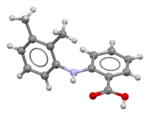Mefenamic acid
Mefenamic acid is a member of the anthranilic acid derivatives (or fenamate) class of nonsteroidal anti-inflammatory drugs (NSAIDs), and is used to treat mild to moderate pain.[1][2]
 | |
 | |
| Clinical data | |
|---|---|
| Trade names | Ponstel, Ponstan, many others |
| AHFS/Drugs.com | Monograph |
| MedlinePlus | a681028 |
| Pregnancy category |
|
| Routes of administration | By mouth, suppositories |
| ATC code | |
| Legal status | |
| Legal status | |
| Pharmacokinetic data | |
| Bioavailability | 90% |
| Protein binding | >90% |
| Metabolism | Hepatic (CYP2C9) |
| Elimination half-life | 2 hours |
| Excretion | Urine (52–67%), faeces (20–25%) |
| Identifiers | |
| |
| CAS Number | |
| PubChem CID | |
| IUPHAR/BPS | |
| DrugBank | |
| ChemSpider | |
| UNII | |
| KEGG | |
| ChEBI | |
| ChEMBL | |
| CompTox Dashboard (EPA) | |
| ECHA InfoCard | 100.000.467 |
| Chemical and physical data | |
| Formula | C15H15NO2 |
| Molar mass | 241.290 g·mol−1 |
| 3D model (JSmol) | |
| |
| |
| | |
Its name derives from its systematic name, dimethylphenylaminobenzoic acid. It was discovered and brought to market by Parke-Davis as Ponstel in the 1960s. It became generic in the 1980s and is available worldwide under many brand names such as Meftal.[3]
Medical uses
Mefenamic acid is used to treat pain and inflammation in rheumatoid arthritis and osteoarthritis, postoperative pain, acute pain including muscle and back pain, toothache and menstrual pain, as well as being prescribed for menorrhagia.[4][5][6]
There is evidence that supports the use of mefenamic acid for perimenstrual migraine headache prophylaxis, with treatment starting two days prior to the onset of flow or one day prior to the expected onset of the headache and continuing for the duration of menstruation.[2]
Mefenamic acid is recommended to be taken with food.[7]
Contraindications
Mefenamic acid is contraindicated in people who have shown hypersensitivity reactions such as urticaria and asthma to this drug or to other NSAIDs (e.g. aspirin); those with peptic ulcers or chronic inflammation of the gastrointestinal tract; those with kidney or liver disease; heart failure; after coronary artery bypass surgery; and during the third trimester of pregnancy.[5][8]
Side effects
Known mild side effects of mefenamic acid include headaches, nervousness, and vomiting. Potentially serious side effects may include diarrhea, gastrointestinal perforation, peptic ulcers, hematemesis (vomiting blood), skin reactions (rashes, itching, swelling; in rare cases toxic epidermal necrolysis) and rarely blood cell disorders such as agranulocytosis.[9][5] It has been associated with acute liver damage.[10]
In 2008 the US label was updated with a warning concerning a risk of premature closure of the ductus arteriosus in pregnancy.[11]
In October 2020, the U.S. Food and Drug Administration (FDA) required the drug label to be updated for all nonsteroidal anti-inflammatory medications to describe the risk of kidney problems in unborn babies that result in low amniotic fluid.[12][13] They recommend avoiding NSAIDs in pregnant women at 20 weeks or later in pregnancy.[12][13]
Overdose
Symptoms of overdosing include kidney failure, gastrointestinal problems, bleeding, rashes, confusion, hallucinations, vertigo, seizures, and loss of consciousness. It is treated with induction of vomiting, gastric lavage, bone char, and control of electrolytes and vital functions.[5]
Interactions
Interactions are broadly similar to those of other NSAIDs. Mefenamic acid interferes with the anti–blood clotting mechanism of Aspirin. It increases the blood thinning effects of warfarin and phenprocoumon because it displaces them from their plasma protein binding and increases their free concentrations in the bloodstream. It adds to the risk of gastrointestinal ulcera associated with corticosteroids and selective serotonin reuptake inhibitors. It can increase the risk for adverse effects of methotrexate and lithium by lowering their excretion via the kidneys. It can increase the kidney toxicity of ciclosporin and tacrolimus. Combination with antihypertensive drugs such as ACE inhibitors, sartans and diuretics can decrease their effectiveness as well as increase the risk for kidney toxicity.[5][6]
Pharmacology
Mechanism of action
Like other members of the anthranilic acid derivatives (or fenamate) class of NSAIDs, it inhibits both isoforms of the enzyme cyclooxygenase (COX-1 and COX-2). This prevents formation of prostaglandins,[10][14] which play a role in pain sensitivity, inflammation and fever, but also in hemostasis, kidney function, sustaining of pregnancy, and protection of the gastric mucosa.[15]
Pharmacokinetics

Mefenamic acid is rapidly absorbed from the gut and reaches highest concentrations in the blood plasma after one to four hours. When in the bloodstream, over 90% of the substance are bound to plasma proteins. It probably crosses the placenta, and is found in the breast milk in small amounts.[5][8]
It is metabolized by the liver enzyme CYP2C9 to the only weakly active 3'-hydroxymethylmefenamic acid. 3'-carboxymefenamic acid has also been identified as a metabolite, as well as carboxy glucuronides of all three substances. Mefenamic acid and its metabolites are excreted via the urine (52–67%) and the faeces (20–25%, or less than 20% following another source). The parent substance has a biological half-life of two hours; the half-life of its metabolites may be longer.[5][6][8]
History
Scientists led by Claude Winder from Parke-Davis invented mefenamic acid in 1961, along with fellow members of the class of anthranilic acid derivatives, flufenamic acid in 1963 and meclofenamate sodium in 1964.[16] U.S. Patent 3,138,636 on the drug was issued in 1964.[17][18]
It was approved in the UK in 1963 as Ponstan, in West Germany in 1964 as Ponalar and in France as Ponstyl, and the US in 1967 as Ponstel.[10][18]
Chemistry
Synthesis
Analogous to fenamic acid, this compound may be made from 2-chlorobenzoic acid and 2,3-dimethylaniline.[19]
Society and culture
Availability and pricing
Mefenamic acid is generic and is available worldwide under many brand names.[3]
In the US, wholesale price of a week's supply of generic mefenamic acid has been quoted as $426.90 in 2014. Brand-name Ponstel is $571.70.[20] By contrast, in the UK, a weeks supply is £1.66, or £8.17 for branded Ponstan.[21]
Research
While studies have been conducted to see if mefenamic acid can improve behavior in transgenic mouse models of Alzheimer's disease[22][23] there is little evidence that mefenamic acid or other NSAIDs can treat or prevent Alzheimer's in humans; clinical trials of NSAIDs other than mefenamic acid for treatment of Alzheimer's have found more harm than benefit.[24][25][26] A small controlled study of 28 human subjects showed improved cognitive impairment using mefenamic acid non-steroidal anti-inflammatory therapy.[27]
See also
References
- "Ponstel Label" (PDF). U.S. Food and Drug Administration. 19 February 2008.
- Pringsheim T, Davenport WJ, Dodick D (April 2008). "Acute treatment and prevention of menstrually related migraine headache: evidence-based review". Neurology. 70 (17): 1555–1563. doi:10.1212/01.wnl.0000310638.54698.36. PMID 18427072. S2CID 27966664.
- "International listings for mefenamic acid". Drugs.com. Retrieved 3 July 2015.
- "Digital Medicines Information Suite". MedicinesComplete. doi:10.18578/bnf.855907230. Retrieved 2020-04-18.
- Austria-Codex (in German). Vienna: Österreichischer Apothekerverlag. 2020. Parkemed 500 mg-Filmtabletten.
- "mediQ: Mefenaminsäure". Retrieved 2020-07-23.
- "Side effects for Mefenamic Acid". Medline Plus. National Institutes of Health.
- Cerner Multum. "Mefenamic Acid". Drugs.com. Retrieved 2020-07-22.
- Aronson JK (2010). eyler's Side Effects of Analgesics and Anti-inflammatory Drugs. Amsterdam: Elsevier Science. p. 334. ISBN 978-0-08-093294-1.
- "Mefenamic Acid". LiverTox: Clinical and Research Information on Drug-Induced Liver Injury [Internet]. Bethesda (MD): National Institute of Diabetes and Digestive and Kidney Diseases. January 2020. PMID 31643361. Retrieved 28 November 2019.
- "Safety Labeling Changes: Ponstel (mefenamic acid capsules, USP)". Center for Drug Evaluation and Research (CDER). U.S. Food and Drug Administration. March 2008. Archived from the original on 4 November 2009.
- "FDA Warns that Using a Type of Pain and Fever Medication in Second Half of Pregnancy Could Lead to Complications". U.S. Food and Drug Administration (FDA) (Press release). 15 October 2020. Retrieved 15 October 2020.
 This article incorporates text from this source, which is in the public domain.
This article incorporates text from this source, which is in the public domain. - "NSAIDs may cause rare kidney problems in unborn babies". U.S. Food and Drug Administration. 21 July 2017. Retrieved 15 October 2020.
 This article incorporates text from this source, which is in the public domain.
This article incorporates text from this source, which is in the public domain. - Prusakiewicz JJ, Duggan KC, Rouzer CA, Marnett LJ (August 2009). "Differential sensitivity and mechanism of inhibition of COX-2 oxygenation of arachidonic acid and 2-arachidonoylglycerol by ibuprofen and mefenamic acid". Biochemistry. 48 (31): 7353–7355. doi:10.1021/bi900999z. PMC 2720641. PMID 19603831.
- Mutschler E (2013). Arzneimittelwirkungen. Wissenschaftliche Verlagsgesellschaft Stuttgart. pp. 205–206, 444. ISBN 978-3-8047-2898-1.
- Whitehouse MW (2009). "Drugs to treat inflammation: a historical introduction". Current Medicinal Chemistry. 4 (25): 707–729 (718). doi:10.2174/092986705774462879. ISBN 978-1-60805-207-3. PMID 16378496.
- US 3,138,636, Scherrer RA, issued 23 June 1964, assigned to Parke Davis and Co LLC
- Sittig M (1988). "Mefenamic acid". Pharmaceutical Manufacturing Encyclopedia (PDF). Vol. 1 (Second ed.). Noyes Publications. pp. 918–919. Archived from the original (PDF) on 2007-10-23.
- Trinus FP, Mokhort NA, Yagupol'skii LM, Fadeicheva AG, Danilenko VS, Ryabukha TK, Fialkov YA, Kirichek LM, Endel'man ÉS, Get'man GA (1977). "Mefenamic acid — A Nonsteroid Antiinflammatory Agent". Pharmaceutical Chemistry Journal. 11 (12): 1706–1711. doi:10.1007/BF00778304. S2CID 45211486.
- "Drugs for Osteoarthritis". The Medical Letter. 56 (1450): 80–84. September 2014. PMID 25157683.
- "Access leading drug and healthcare references". www.medicinescomplete.com. Retrieved 19 September 2014.
- Joo Y, Kim HS, Woo RS, Park CH, Shin KY, Lee JP, et al. (January 2006). "Mefenamic acid shows neuroprotective effects and improves cognitive impairment in in vitro and in vivo Alzheimer's disease models". Molecular Pharmacology. 69 (1): 76–84. doi:10.1124/mol.105.015206. PMID 16223958. S2CID 20982844.
- Daniels MJ, Rivers-Auty J, Schilling T, Spencer NG, Watremez W, Fasolino V, et al. (August 2016). "Fenamate NSAIDs inhibit the NLRP3 inflammasome and protect against Alzheimer's disease in rodent models". Nature Communications. 7: 12504. Bibcode:2016NatCo...712504D. doi:10.1038/ncomms12504. PMC 4987536. PMID 27509875.
- Miguel-Álvarez M, Santos-Lozano A, Sanchis-Gomar F, Fiuza-Luces C, Pareja-Galeano H, Garatachea N, Lucia A (February 2015). "Non-steroidal anti-inflammatory drugs as a treatment for Alzheimer's disease: a systematic review and meta-analysis of treatment effect". Drugs & Aging. 32 (2): 139–147. doi:10.1007/s40266-015-0239-z. PMID 25644018. S2CID 35357112.
- Jaturapatporn D, Isaac MG, McCleery J, Tabet N (February 2012). "Aspirin, steroidal and non-steroidal anti-inflammatory drugs for the treatment of Alzheimer's disease". The Cochrane Database of Systematic Reviews (2): CD006378. doi:10.1002/14651858.CD006378.pub2. PMID 22336816.
- Wang J, Tan L, Wang HF, Tan CC, Meng XF, Wang C, et al. (2015). "Anti-inflammatory drugs and risk of Alzheimer's disease: an updated systematic review and meta-analysis". Journal of Alzheimer's Disease. 44 (2): 385–396. doi:10.3233/JAD-141506. PMID 25227314.
- Melnikov V, Tiburcio-Jimenez D, Mendoza-Hernandez MA, Delgado-Enciso J, De-Leon-Zaragoza L, Guzman-Esquivel J, et al. (2021). "Improve cognitive impairment using mefenamic acid non-steroidal anti-inflammatory therapy: additional beneficial effect found in a controlled clinical trial for prostate cancer therapy". American Journal of Translational Research. 13 (5): 4535–4543. PMC 8205720. PMID 34150033.
Further reading
- "Mefenamic Acid". MedlinePlus Drug Information. U.S. National Library of Medicine. Retrieved 28 September 2005.
- "Ponstel Pharmacology, Pharmacokinetics, Studies, Metabolism - Mefenamic Acid". RxList Monographs. Archived from the original on 2005-11-09. Retrieved 28 September 2005.
- Page J, Henry D (March 2000). "Consumption of NSAIDs and the development of congestive heart failure in elderly patients: an underrecognized public health problem". Archives of Internal Medicine. 160 (6): 777–84. doi:10.1001/archinte.160.6.777. PMID 10737277.